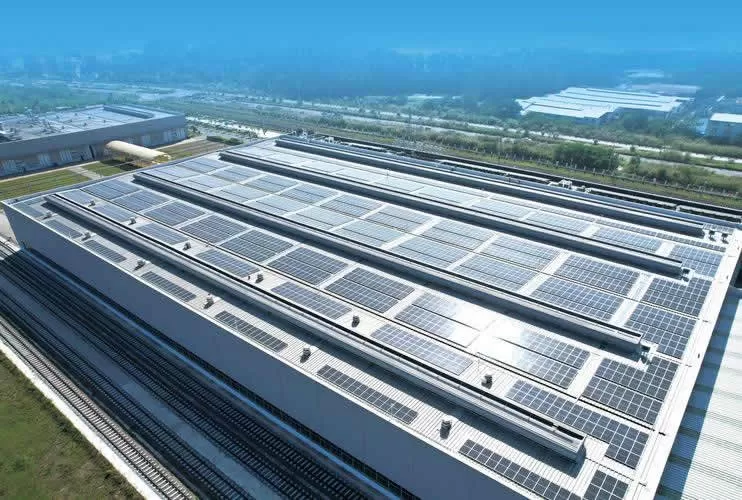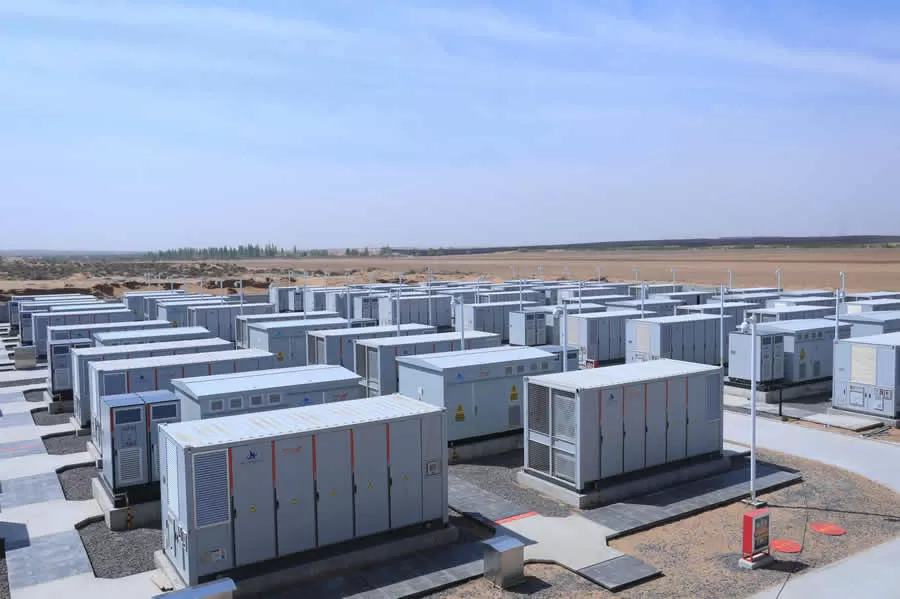
9.3 MW Distributed Photovoltaic Energy Storage Project in Guangdong and Guangxi, China
In the context of accelerated transformation of the global energy structure, distributed photovoltaic storage solutions are becoming the core energy option for industrial and commercial users, rural revitalization, and urban low-carbon development with the qualities of “decentralization”, “flexibility and efficiency”. With the multiple advantages of on-site power generation, peak storage and flexible scheduling, distributed solar storage solutions are becoming an important breakthrough for the industry transformation and safe operation of the power grid.Brice Solar will comprehensively analyze the core advantages of the solar distributed solar storage system from the three perspectives of technical principles, successful cases and market prospects, and discuss how to build an intelligent, green and efficient energy storage system in the future.
1、Solar Distributed Light Storage Solution Overview
Solar distributed photovoltaic storage system is the solar photovoltaic power generation and storage equipment in a decentralized manner deployed on the user side or in the region, through the intelligent control system to achieve power generation, storage, peak shifting, auxiliary services and other multi-functional integration of integrated energy systems. This solution is different from the traditional centralized power plant, and its main features include:
Local consumption and reduction of line losses;
Smoothing new energy output and supporting grid frequency regulation and peak adjustment;
Emergency backup and highly reliable power supply.
This distributed PV energy storage architecture has been widely used in different scenarios such as industrial and commercial, residential, and even micro-grid, and provides strong technical support for the national new energy “mandatory distribution and storage” policy.
2. Technical Advantages of Distributed Photovoltaic
2.1 Enhance energy utilization rate and economic benefits
Distributed photovoltaic storage program realizes in-situ energy storage during the time when PV power generation is sufficient, and releases electricity during the peak time, effectively reducing transmission and distribution losses. The energy storage system can participate in peak and valley arbitrage, auxiliary services and demand response, further improving system economics. For example, studies have shown that through the “two charging and two releasing” strategy, not only can optimize the peak and valley tariff difference, but also shorten the payback period of the energy storage investment, the overall benefits are significant.
2.2 Smoothing fluctuations and improving system stability
The inherent intermittency and randomness of photovoltaic power generation often cause impact on the power grid. Distributed energy storage through rapid response, adjust the output power, smooth PV fluctuations, reduce the impact on the grid. At the same time, in the event of a power outage or sudden failure, the energy storage system can be quickly switched to emergency power to protect the stability of the power supply of the key load.
2.3 Flexible deployment, good system scalability
Due to the modular design of the distributed photovoltaic storage system, the installation location is flexible and the capacity configuration can be adjusted according to the actual load on the user side. For example, rooftop distributed photovoltaic projects can be directly integrated with home or industrial and commercial energy storage, realizing “nearby power generation, nearby power”, greatly improving the utilization rate of photovoltaic and system response speed.
2.4 Intelligent management and monitoring
Modern distributed photovoltaic storage program relies on advanced energy management system (EMS) to realize real-time monitoring and intelligent scheduling.EMS can automatically adjust the energy storage charging and discharging strategy according to the weather forecast, grid demand and load conditions, which not only ensures the efficient operation of the system, but also provides data support for the later maintenance and fault warning.
3. distributed photovoltaic power generation and energy storage system combination method
3.1 DC coupling method
DC coupling method is to connect the DC power generated by the PV power generation system directly with the energy storage system. Specific realization steps are as follows:
Photovoltaic power generation system: first, the photovoltaic power generation system converts sunlight into DC power through photovoltaic modules.
DC conversion and integration: After the generated DC power is integrated by a convergence box and other equipment, a part of it is directly supplied to the DC loads for use, and another part is charged for the energy storage battery through a DC converter.
Energy Storage System: The energy storage battery charges the DC power after receiving it and releases the DC power when needed.
Inverter: When needed to power AC loads, the DC power released by the storage battery is converted to AC power through an inverter for use by AC loads.
DC coupling method has the characteristics of simple structure, less energy conversion links and small energy loss, and is suitable for communication base stations, data centers and other application scenarios with more DC loads and higher requirements for power quality.
3.2 AC coupling method
Under the AC coupling method, the PV power generation system is connected to the AC power grid through an inverter respectively. The specific realization steps are as follows: PV power generation system: DC power generated by the PV power generation system is first converted to AC power through the inverter.
Grid connection: The converted AC power is connected to the grid or used by AC loads.
Energy storage system: When energy storage is required, the AC power from the grid is converted to DC power through the energy storage inverter to charge the energy storage battery.
Discharge process: During the discharge process, the DC power from the energy storage system is then converted to AC power through the energy storage inverter for use by AC loads or fed back to the grid.
The AC coupling method has high flexibility and compatibility, and can be efficiently integrated with the existing AC grid system, which is suitable for scenarios such as small factories, commercial buildings and residential neighborhoods.
3.3 Hybrid coupling
The hybrid coupling method combines the characteristics of DC coupling and AC coupling, which can realize the direct DC coupling between PV power generation system and energy storage system, and also interact with the power grid through AC coupling. The specific realization is as follows:
Flexible choice: PV power generation system can choose DC or AC output according to the actual situation.
Energy storage system: DC or AC charging and discharging methods can be selected according to the needs.
Energy management: more flexible and efficient energy management is realized through intelligent control system.
The hybrid coupling approach is suitable for complex and changing power demand scenarios, whether it is an application that requires stable DC power or a scenario that interacts with the grid in a highly efficient manner, it can provide the optimal solution.
4. Successful Cases of Distributed Energy Storage
4.1 Industrial and Commercial Distributed Optical Storage Applications
In Zhejiang, Jiangsu and other regions of China, many industrial and commercial buildings utilize rooftop photovoltaic and energy storage systems for joint applications, which can realize the reduction of electricity cost and grid load balance by smoothing the power generation curve and shaving peaks and filling valleys. Some cases show that after releasing electricity from the energy storage system during the peak period of electricity consumption, the expenditure on electricity bill of enterprises is significantly reduced, while the overall revenue of the system can be improved.
4.2 Demonstration of Microgrid and Household Light Storage Integration
Taking an urban distributed microgrid project in Northwest China as an example, a stable microgrid has been constructed using 20kWp PV modules and an energy storage system of about 25kWh, which not only realizes dual-mode operation in both grid-connected and off-grid modes, but also ensures power supply to nearly 50% of important loads under unfavorable conditions, such as continuous cloudy and rainy conditions. Such applications have played a significant role in improving grid security and optimizing power quality.
4.3 Cross-Industry Strategic Cooperation for Industry Integration
Recently, a number of leading enterprises in China (such as Sungrow Energy and Konka Group) reached a strategic cooperation in the field of distributed light storage, and jointly laid out the 1GW household light storage market. The two sides integrate their respective technology, channel and resource advantages, and take product differentiation and intelligent management as the grips to help distributed light storage solutions gain more recognition in the market.
5. distributed energy storage market outlook and development trend
5.1 Strong policy support
With the Chinese Energy Bureau proposed “centralized and distributed”, and promote distributed PV projects supporting energy storage, to strengthen the safety and economy of electricity. Many places introduced the “new energy mandatory storage” policy for the application of distributed photovoltaic storage provides a solid policy support for the development of the industry to create a favorable market environment.
5.2 Costs continue to decline and technological breakthroughs
With the maturity of lithium batteries and sodium-ion batteries and other energy storage technologies and energy management algorithms continue to optimize, the construction cost of energy storage system has been declining year by year, the system integration and intelligent monitoring technology is also progressing. Thus, lower overall investment and shorter payback period can be realized, bringing considerable profit prospects for distributed light storage solutions.
5.3 Strong market demand and diverse application scenarios
In diverse scenarios such as residential, industrial and commercial, and microgrids, users' demand for green, low-carbon, safe and stable power supply is growing. With its flexible deployment and intelligent scheduling functions, distributed optical storage solution meets the individual needs of different power scenarios, and is expected to promote the deep integration and cross-border cooperation in the field of new energy in the future.

PV Shared Energy Storage Plant in Ningxia, China
Summary
Solar distributed storage solutions not only enhance the overall utilization efficiency and economic benefits of photovoltaic power generation, but also significantly improve the security and stability of the power grid, to promote energy transformation and the construction of smart grid provides a strong technical support. Driven by policy, technological innovation and market demand, distributed storage is ushering in an unprecedented period of rapid development. Enterprises should seize the opportunity to meet the rising green energy demand of users through intelligent and diversified products and services, and jointly write a new chapter of low-carbon and high-efficiency energy future.
If you have doubts about solar distributed photovoltaic energy storage, you can contact us, we provide you with customized solar distributed photovoltaic energy storage solutions.









One step to find us,we will respond within 24 hours.
More Contact Details
008613738639386
[email protected]